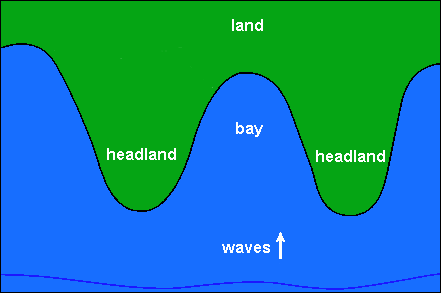∎Bay ➤ A bay is a body of water that is partly surrounded by land. Bays empty out into larger bodies of water like oceans and lakes. They are sometimes confused with other bodies of water such as gulfs, but bays are typically smaller. There are various ways in which bays can form. The largest bays have developed through plate tectonics. As the super-continent Pangaea broke up along curved and indented fault lines, the continents moved apart and left large bays; these include the Gulf of Guinea, the Gulf of Mexico, and the Bay of Bengal, which is the world's largest bay. Bays also form through coastal erosion by rivers and glaciers. A bay formed by a glacier is a fjord. Rias are created by rivers and are characterized by more gradual slopes. Bays can also be found along the shores of lakes. Bays are usually much calmer and more protected than seas or oceans . The land surrounding a bay often reduces the strength of winds and blocks waves. Most bays make excellent harbors and major port cities are often located on them . eg. - Mumbai.
∎Gulf ➤ A gulf is a portion of the ocean that penetrates land. They are generally larger and more deeply indented than bays. Hence, gulf = a large bay. Like bays, they often make excellent harbors. Many gulfs are major shipping areas, such as the Persian Gulf, Gulf of Mexico, and Gulf of Aden. The Gulf of Mexico, bordered by the United States, Mexico, and the island nation of Cuba, is the worlds largest gulf. The process of up-welling occurs near the Florida coast of the gulf, creating a rich variety of sea life. up-welling is the process in which cold, nutrient-rich water from the bottom of the gulf is brought to the surface. The Gulf Stream, one of the most powerful ocean currents in the world, originates in the Gulf of Mexico.
∎Strait ➤ A strait is a narrow passage that connects two larger bodies of water, ie. straits let you sail 'straight' on through from one body of water to another. They are naturally occuring, narrow and are generally navigable. Straits are also known to be loci for sediment accumulation. Usually, sand-size deposits occur on both the two opposite strait exits, forming sub-aqueous fans or deltas. A strait lies between two land masses while connecting two larger bodies of water (opposite of Isthmus). Some straits also have the potential to generate significant tidal power. eg. of straits -- strait of Hormuz , Malacca strait , Dover strait etc.
◼Isthmus ➤ An isthmus is a strip of narrow land with water on each side, connecting two greater land masses. An isthmus can be found where two land masses join through a narrow portion of land. Throughout history, isthmuses have been strategic sites for both trade and military purposes. They often serve as key locations for ports, canals, and links between land and sea trade routes. Building canals to cross isthmuses is fairly common. eg.- the Panama Canal crosses the Isthmus of Panama, connecting the North Atlantic and Pacific Oceans; the Suez Canal connects the Mediterranean Sea and the Red Sea etc. When the Isthmus of Panama was formed , it made it possible for animals and people to migrate from South America to North America. It also made it possible for important ocean currents to form. Without the Isthmus of Panama, the weather on Earth would be much different than it is today. The Isthmus of Panama formed as a result of volcanic activity that created a chain of islands. Over time, sediment collected between the islands, forming the isthmus. In other areas of the world, isthmuses may form as a result of the movement of tectonic plates, rising water levels along fault lines, and the movement of waves and tides.
◼ Peninsula ➤ A peninsula is a piece of land that is almost entirely surrounded by water but is connected to the mainland on one side. The water surrounding a peninsula may be a river, lake, ocean, or sea. An isthmus is a land connection between two bigger landmasses, while a peninsula is rather a land protrusion which is connected to a bigger landmass on one side only and surrounded by water on all other sides. One of the ways peninsulas come to exist is by the movement of lithospheric tectonic plates. Another way that peninsulas are formed is by changing levels in water. Water rising against land and slowly receding over a number of years causes erosion, which may result in peninsula formation. The Arabian Peninsula is the largest peninsula in the world. Some other well known peninsula are the Indian peninsula, the Horn of Africa, Baja peninsula(California), Cape York peninsula (Australia) etc.




Comments
Post a Comment